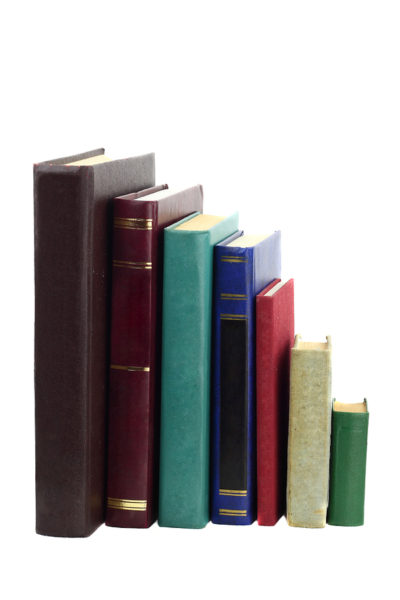Trim size is one of those terms we use frequently when talking about the dimensions of your printed book.
The term comes from the fact that during the printing process the pages of the book first printed on large sheets which are folded, glued, and later “trimmed” to a specific size. (This linked video shows the entire book printing process.) Go to your shelf and pull down a few titles and measure the page dimensions to see a physical example of what is described below.
There aren’t any hard and fast “rules” about what size a book should be. It is determined by many factors, almost too numerous to explain. But there are some general guidelines and terms.
Below I’ll list the publisher jargon that describes this particular trim size. Then will be the dimensions of that book. The first number is the short side measurement the second number is the tall or long-side measurement. This is the measurement of the paper. A hardcover book has a cover that is a little bit larger than the trim size of the paper.
Mass Market – 4-1/4” x 7”
These are the ones you might see in the grocery store checkout line or in an airport store. Years ago special racks and shelves were built specifically for this size. It suggested an inexpensive version of a book. Most often this is used in the fiction category.
Recently this trim size has been affected by the rise of ebooks. Fewer titles are done in mass market.
Book contracts often have a separate royalty rate for this trim size since the retail price is lower and in many cases the book can be returned to the publisher by simply tearing the cover off and returning that stripped book cover. It is called “Strip Cover Returns.”
Trade Paperback – ranges from 5-1/2” x 8 1/2″ to 6” x 9”
This is the go-to trim size for most paperbacks in today’s market. Fiction tends toward the 5 1/2” x 8 1/2″ size, but not always.
This 5.5” x 8.5” size is also efficient because it is the dimension of a regular piece of paper folded in half.
The larger 6” x 9” for some publishers is the default for textbooks or certain types of non-fiction.
There are times were the larger trim size is an advantage because there is more “real estate” for the content to fit. Thus you can keep the content the same but use fewer pages to print, which costs less money. There is a minor difference in cost between 6×9 and 5.5×8.5.
Manuals or Workbooks – 8 1/2″ x 11”
This is a common trim size because each page is like a regular sheet of paper. The only problem for this is in a brick-and-mortar store. Bookstore shelves are only 10 inches high. Thus workbooks are either placed on their side in the shelf or stuck on the top corner; making them hard to find later.
A number of smart publisher realized this and use a 7” x 9” trim size for work books.
Other Trim Sizes
I can hear you saying “But I have book that are very different from any of these mentioned!” There are no rules per se. Gift books, Children’s books, devotionals, etc can take almost any form. For example, I have a Bible Timeline book in my office that is 17 1/2″ x 14” with fold out pages.
The only limitation is the creativity of the publisher!
Who Decides the Trim Size?
Early in the publishing process the acquisitions editor talks to marketing and sales to discuss trim size, especially if something a little different than normal will be used.
In my days at Bethany House I experimented with non-fiction books printed using a 6” x 8 1/2″. We had been told that 6×9 would not work with the racks in grocery stores and airport spin racks. So we “trimmed” a half inch off the long side and they fit! We were able to place a number of significant non-fiction titles in those racks because of that trim size choice.
Your Turn:
Share with us the trim size mix of books on one of the shelves in your library. Are they mostly 5.5 x 8.5 trade paperback? Or something else?


